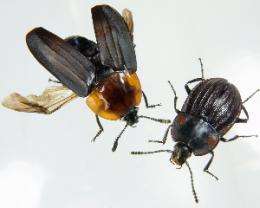A novel hypothesis for beetle diversification -- Loss of flight promotes beetle diversification

Professor Teiji Sota, Department of Zoology at Kyoto University, and his group demonstrated that loss of flight has been the major driving force for beetle diversification. This finding has been published in Nature Communications on January 31, 2012.
Insects are an enormously species-rich group (930,000 species) representing more than half of all described species. One of the most important events for the insect diversification is the acquisition of flight, which occurred approximately 400 million years ago. Flight ability facilitates the search and colonization of distant habitats, wide dispersal, and the ability to find mates and food. However, despite the advantages, many insect species of various lineages have lost their ability to fly by losing flight muscles and wings. This is because the maintenance of these flight apparatuses is energetically expensive and allocating these energies to survival and reproduction can be more adaptive under some conditions. Low dispersal ability of flightless species would lower the rate of gene flow, eventually lead to differentiations among populations, and consequently result in higher rates of allopatric speciation. Thus, the loss of flight in various lineages might be an important factor contributing to current insect diversity.
We tested our hypothesis that the loss of flight promotes allopatric speciation due to limited dispersal and leads to the high species richness in Coleoptera (350,000 species; 40% of all insects) using carrion beetles (Coleoptera: Silphidae) as a model system. We demonstrated that flightless species retain higher genetic differentiation among populations and comprise a higher number of genetically distinct lineages than flight-capable species, indicating high possibility for allopatric speciation. Furthermore, we elucidated that the speciation rate with the flightless state is twice that with the flight-capable state. Moreover, a meta-analysis of 51 beetle species from 15 families revealed higher genetic differentiation among populations in flightless compared to flight-capable species.
A previous study suggested that beetle diversity has increased through the adaptive radiation associated with the diversification of angiosperms in the Cretaceous (Farrell 1998. Science 281: 555-559). However, a recent study revealed that the radiation of beetle families preceded the rise of angiosperms and that different lineages have survived and continued to diverge ever since (Hunt et al. 2007. Science 318: 1913-1916). Thus, beetles have steadily diversified after the adaptive radiation in the early stage of their evolutionary history. Wingless species represent approximately 10% of beetle species, especially common in some groups such as ground beetles (Carabidae), which include 20-25% of wingless species among about 40,000 species. A higher proportion of beetle species would be flightless due to the lack of flight muscles, and hence the overall proportion of flightless species should be higher. Therefore, loss of flight may be a common key event that contributes to the beetle diversification.
More information: Ikeda, Hiroshi, et al. Loss of flight promotes beetle diversification. Nature Communications 3: 648, 2012; DOI: 10.1038/ncomms1659 . Published January 31, 2012.
Journal information: Nature Communications
Provided by Kyoto University

















